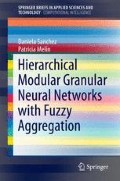Abstract
This chapter offers the conclusions.
You have full access to this open access chapter, Download chapter PDF
Keywords
- Fuzzy logicFuzzy Logic
- High-level Complex
- Hierarchical Genetic Algorithm
- Complex Database
- Fuzzy Inference System
These keywords were added by machine and not by the authors. This process is experimental and the keywords may be updated as the learning algorithm improves.
In this book, a new method of modular granular neural networks and their integrations using fuzzy logic is proposed. The main contribution is the development of a method based on granular computing where, the granulation is used in 2 levels. The information or data used in the modular neural networks is granulated to improve the effectiveness of these MNNs, and the integration of responses is performed using a fuzzy inference system where, the granulation is also performed. Different tests (non-optimized) were performed, where the number of modules and data for the training phase were modified. Optimizations were also performed to improve the results obtained and better results were achieved. The combination of responses is performed using fuzzy logic where a hierarchical genetic algorithm was developed to find the optimal fuzzy integrator parameters. Better results were obtained using the optimizations developed in this research work. A new method to work with big databases was also proposed, where based on the database complexity a optimization is performed.
As future works, the granulation performed using the database complexity in this research work was only used with a biometric measure. The future work for this part would be, if more biometric measures are used, how to integrate each biometric measure of a persons, if for example, in the case of face, if a person has a medium complexity level, in the iris has a high complexity level, in the ear a low complexity level and with voice has a high complexity level. The question would be, what is his final new ID? An answer would perhaps be to find a method (maybe a fuzzy inference system ), where the inputs would be the percentage of complexity of each biometric measure , logically the number of inputs would be the number of biometric measured used, and a final percentage of complexity is obtained, and so, a final new ID is obtained for each person and the optimization based on the database complexity is performed for each biometric measure.
The proposed HGA for fuzzy inference system optimization can be easily applied to another application, where a fuzzy inference system is used. Finally, the proposed granulations in this book can be adapted to other optimization methods such as; particle swarm optimization, ant colony system or another bio inspired optimization algorithm.
Author information
Authors and Affiliations
Corresponding author
Rights and permissions
Copyright information
© 2016 The Author(s)
About this chapter
Cite this chapter
Sanchez, D., Melin, P. (2016). Conclusions. In: Hierarchical Modular Granular Neural Networks with Fuzzy Aggregation. SpringerBriefs in Applied Sciences and Technology(). Springer, Cham. https://doi.org/10.1007/978-3-319-28862-8_6
Download citation
DOI: https://doi.org/10.1007/978-3-319-28862-8_6
Published:
Publisher Name: Springer, Cham
Print ISBN: 978-3-319-28861-1
Online ISBN: 978-3-319-28862-8
eBook Packages: EngineeringEngineering (R0)

